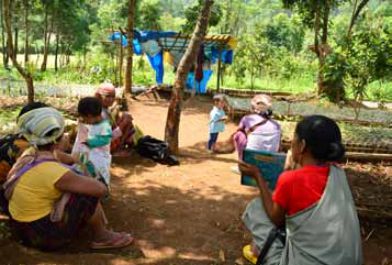
Sahsniang CLF (West Jaintia Hills) The Sahsniang CLF was formed in July 2011 with the facilitation of Meghalaya Livelihoods Improvement Project for the Himalayas (MLIPH). It comprises 18 SHGs with 187 members covering 1 village. The major livelihood activities of village community members includes agriculture (paddy, vegetables) livestock, horticulture (banana, orange), and also wage-based employment. The Sahsniang CLF was first introduced to the idea of Community Nursery by the IBDLP programme implementation team. In May 2015, CLF leaders and MBDA staffs came together with this idea to generate income and promote afforestation in the area. Two of the group members, Mrs. Ventina & Mrs. Babiana who are also community nursery master trainers, attended two days training on Community Nursery at Cham Cham Cluster Training Centre. The IBDLP team provided them with practical handholding through periodic supervision and monitoring. MBDA till date has invested Rs. 90,000 and the amount is utilised for purchasing materials such as poly bags, plastic water tank, pipe and other equipment.
OPERATIONAL DETAILS
This Community Nursery is located few metres away from the main road, spread across half hectare of land that was given by Mrs. Babiana Laloo. She has contributed the land free of cost for 5 years but will be getting some income depending on the revenue generated from the land. During the initial discussions within the CLF, it was decided that the community nursery’s responsibility would entirely be taken up by the Chiruplang SHG. It is the responsibility of the Group leaders of Chiruplang SHG to monitor the activity and assign work to the members as per the requirement. However, every member of the CLF is allowed work and earn labour in the community nursery and is provided with a wage at the rate of Rs. 200 a day for women and Rs. 300 a day for men depending on the availability of work. At present, the group has about 13,000 saplings of different local species (with approximate cost of Rs. 7 X 13,000= Rs. 91,000). Selection of species is done by the community on the basis of economic value and availability of species in the area. The species available in the nursery include Vituo, Dein Puma, Chirngan, Rtiang, Sluka, Laphiang, Deinling, Jack fruit etc. Other horticultural variety such as orange, plum, pear etc shall be added in the coming season. The CLF has not started sales as of now but soon the IBDLP programme implementation team will support with market linkages for at least 60% of the saplings. This CLF has established a good rapport with the Soil & Water Conservation Department as well which will use their sapling for its programmatic activities. The CLF is also in talks with the Block Development Office to explore possibilities of supplying sapling for implementation of other schemes. The initial expected cost of the saplings is 13,000 x Rs. 8 = Rs. 1,04,000. From the income earned 40% will go to CLF and the remaining 60% will be shared among the participating SHGs/members (after clearing the loan amount).
INITIAL CHALLENGES
Challenges include water supply as the nearest water source is quite far from the nursery. This is expected to cause a problem during dry months. The community also appears to need more training in nursery management and accounting. Further steps are being taken to resolve some of these teething issues. For example, a plastic water tank will be placed inside the farm as a water source, and the community is also planning to invest in strong or live fencing.
INSIGHTS FROM COMMUNITY INTERACTIONS
There has been a significant rise in the number of saplings belonging to locally grown tree species and horticultural species at the nursery. This is expected to fetch a fairly good income in addition to increasing green/ forest coverage in the area. Community members believe that as long as there is a market they can successfully raise more saplings and make a good income from the activity. A few non-participating members of the village are also beginning to show interest in joining the activity. After seeing the community nursery in the village, a few community members said that perhaps even individual households should start such nurseries, even if just for their own use.